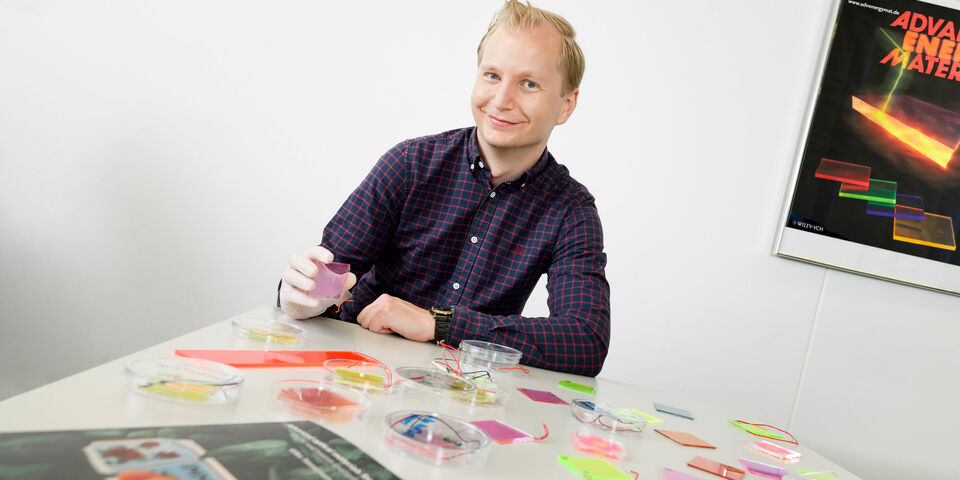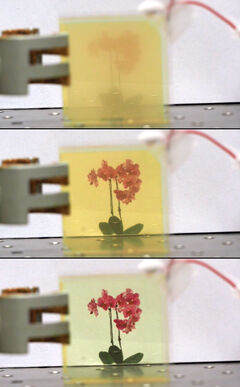Home Stretch | Colorful greenhouses
Gilles Timmermans used to think that a greenhouse was just a simple heating box made of glass. Now, he knows that high-tech plays a significant role in the horticultural sector and that it is used to control several processes, including temperature, humidity and CO2 concentrations. Light control, however, still remains a challenge, which is why the PhD candidate at Chemical Engineering & Chemistry developed ‘smart windows.’ And with an added fluorescent color, these windows are also supposed to make greenhouses energy neutral.
The cover of his thesis, which he will defend this afternoon, shows a retro nursery garden and his last name in a stylized typeface. A ‘kind of family heirloom’ that hangs on the walls of his parents’ house. Timmermans ended up in a greenhouse purely by accident, even though his grandfather, whom he never met, used to own a flower and fruit tree nursery.
The field trips he embarked on during his doctoral period were an eyeopener to him. “To me, a greenhouse was a glass box in which you could keep plants warm, so that you can grow larger quantities of tomatoes or pretty flowers. And of course, there still are various greenhouses to which this description applies. But in the majority of greenhouses, technology is used to produce higher yields and, in the end, larger turnovers.”
Light control
An increasing number of greenhouses use automated devices to control indoor climate. Sensors that can turn on the humidification system, windows that open autonomously when temperatures are too high, algorithms that predict and regulate the indoor climate; greenhouses are getting smarter and smarter. Still, that doesn’t apply to influencing the light, Timmermans says.
“Not much is being done currently when it comes to light control. You often see that horticulturists only want a maximum amount of light for their plants. But in the summer, temperatures soon rise too fast and the windows need to be opened. As a consequence, it becomes more difficult to regulate the indoor climate, and various types of vermin can enter the greenhouse.” Automatic shade screens are hardly ever used, Timmermans says, “although in the summer you often see roofs that were painted white. That reduces the amount of bright light that enters the greenhouse. Due to weather influences, that paint gradually starts to peel off, so that the plants are once again left unprotected from sunlight once autumn arrives. But what horticulturists want, is to be able to determine the lighting level in their greenhouse in a fast and reversible way.”
At an earlier stage, the ‘Stimuli-responsive Functional Materials and Devices’ research group headed by professor Albert Schenning, who acted as Timmermans’ supervisor, already developed solar-shading windows in order to reduce the energy use of large buildings. “I used these windows as a basis for my new smart windows,” the PhD candidate explains. “They are all based on liquid crystals, which are also used for LCD displays, for example. The crystals are ordered, but that ordering can be changed easily, which allows you to influence the characteristics of a window.”
Dyes
Timmermans added a special dye to the windows. “I’ve tested several dyes. Temperature allows you to adjust the ordering of the liquid crystals and, consequently, the ordering (and therefore absorption) of certain dyes. This can also be done, incidentally, by switching on an electrical field. But I also used light-sensitive dyes, of which the molecules undergo a change upon exposure to light; one form lets the light enter, whereas the other form absorbs it. The latter form is possibly preferable for a greenhouse as far as climate technology is concerned, light is a more rapid regulator than temperature.”
Wavelength
The fact that the dye has been made fluorescent also makes it possible to emit the light that was absorbed by the windows at a lower wavelength and to concentrate it at the sides of the window. This way, the window will function as a Luminescent Solar Concentrator (LSC), after which it can be coupled to a solar cell and generate its own electricity. “A win-win situation,” Timmermans says.
Can we expect fluorescent skylines in the greenhouse region any time soon? Things won’t move that fast, Timmermans says. “It seems that colored windows can also influence plant growth, red windows probably work better than green ones. We collaborate with Wageningen University within this multidisciplinary project, one of the things they investigate is what light is most efficient for which plant in a certain growth phase. Unfortunately, corona has led to delay here as well. We had the opportunity in China to scale up my five-by-five square centimeters smart test windows to one-by-one square meter, so that we could actually start testing with plants. That’s still on hold for the time being.”
Timmermans hopes that he will eventually be able to make greenhouses even smarter with his windows. In the meantime, he searches for a new challenge in industry, and spends his spare time improving his gardening skills. “I barely manage to keep my houseplants alive,” he says with a smile.



Discussion